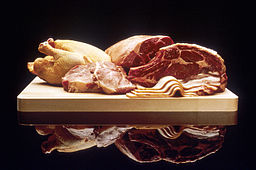By Lisa Palmer
A few weeks ago I attended a panel discussion at the Council on Foreign Relations in Washington, D.C. about food technology of the future. Much of the discussion centered on the production of meat. That’s because Andras Forgacs was on the panel. Forgacs is the CEO of Modern Meadow, a Brooklyn-based, venture-funded company that uses tissue engineering to develop meat and leather in a laboratory setting. Using a 3D printer, the meat is bioprinted onto pectin, the leading ingredient in making jam, and then grown in a sterile vat. It’s a method of beef production from the cells of healthy cow, and it is opening eyes. I wrote about the cutting edge of meat alternatives and cultured meat last May. You can read the story here.
Since becoming a public policy scholar at The Wilson Center in July, I have focused my research and writing on sustainable food production. I’ve written extensively on food technology, beef production, and the search for how to produce more protein for the world’s growing population without using too much water, destroying forests, or depleting ocean fish stocks. So I perked up when heard about the resource conservation methods of Modern Meadow and the potential for printed meat.
Raising animals for food contributes to climate change through the emissions of greenhouse gases and the destruction of forests and grasslands to grow the grain they eat. It also consumes a lot of water. Today it’s a bothersome problem, but it’s increasingly becoming a serious one. Beef production is a driver of global change and the problem will likely get much worse very soon, given the expected growth in the world’s population and demand for meat protein.
You can read about bioprinting and 3D printing of food in my article for FutureFood2050. For the piece, I talked with Hod Lipson, director of Cornell University’s Creative Machines Lab, whose team created the first food 3-D printer about a decade ago. “What food printing offers is a way to combine information technology software and biometrics with cooking in a way that was never possible before,” Lipson told me.
From Lipson’s perspective, 3-D printing is in its infancy and food printing is in the gestational stage. But a handful of companies like Modern Meadow are printing meat (though it’s not yet available to consumers) while others are producing commercially available machines that can print food. I write:
In the future, Lipson anticipates that sophisticated 3-D printing will offer home cooks the ultimate control over the ingredients that go into their food without giving up the convenience of manufactured products.
Here’s the complete story: http://futurefood2050.com/3-d-printers-hit-home/
